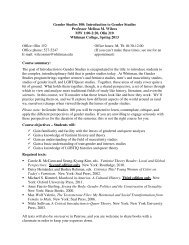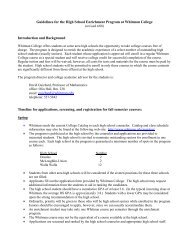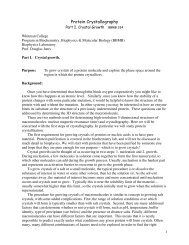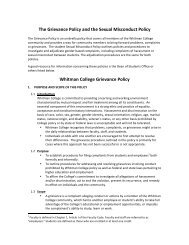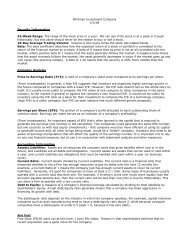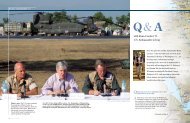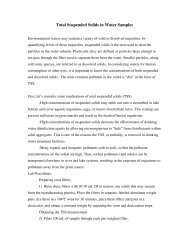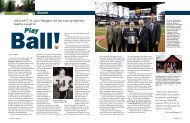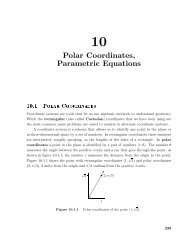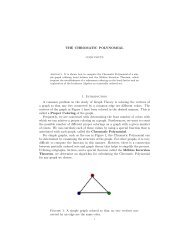Chapter 16 Partial Differentiation
Chapter 16 Partial Differentiation
Chapter 16 Partial Differentiation
Create successful ePaper yourself
Turn your PDF publications into a flip-book with our unique Google optimized e-Paper software.
½º¾ÄÑØ× Ò ÓÒØÒÙØÝ<strong>16</strong>.2 Limits and Continuity 365To develop calculus for functions of one variable, we needed to make sense of the concept ofa limit, which we needed to understand continuous functions and to define the derivative.Limits involving functions of two variables can be considerably more difficult to deal with;fortunately, most of the functions we encounter are fairly easy to understand.The potential difficulty is largely due to the fact that there are many ways to “approach”a point in the x-y plane. If we want to say thatlim(x,y)→(a,b)f(x,y) = L, we need tocapture the idea that as (x,y) gets close to (a,b) then f(x,y) gets close to L. For functionsof one variable, f(x), there are only two ways that x can approach a: from the left or right.But there are an infinite number of ways to approach (a,b): along any one of an infinitenumber of lines, or an infinite number of parabolas, or an infinite number of sine curves,and so on. We might hope that it’s really not so bad—suppose, for example, that alongevery possible line through (a,b) the value of f(x,y) gets close to L; surely this means that“f(x,y) approaches L as (x,y) approaches (a,b)”. Sadly, no.EXAMPLE <strong>16</strong>.2.1 Consider f(x,y) = xy 2 /(x 2 +y 4 ). When x = 0 or y = 0, f(x,y) is0, so the limit of f(x,y) approaching the origin along either the x or y axis is 0. Moreover,along the line y = mx, f(x,y) = m 2 x 3 /(x 2 + m 4 x 4 ). As x approaches 0 this expressionapproaches 0 as well. So along every line through the origin f(x,y) approaches 0. Nowsuppose we approach the origin along x = y 2 . Thenf(x,y) = y2 y 2y 4 +y 4 = y42y 4 = 1 2 ,so the limit is 1/2. Looking at figure <strong>16</strong>.2.1, it is apparent that there is a ridge abovex = y 2 . Approaching the origin along a straight line, we go over the ridge and then dropdown toward 0, but approaching along the ridge the height is a constant 1/2.Fortunately, we can define the concept of limit without needing to specify how aparticular point is approached—indeed, in definition 2.3.2, we didn’t need the concept of“approach.” Roughly, that definition says that when x is close to a then f(x) is close toL; there is no mention of “how” we get close to a. We can adapt that definition to twovariables quite easily:DEFINITION <strong>16</strong>.2.2 LimitSuppose f(x,y) is a function. We say thatlim f(x,y) = L(x,y)→(a,b)if for every ǫ > 0 there is a δ > 0 so that whenever 0 < √ (x−a) 2 +(y −b) 2 < δ,|f(x,y)−L| < ǫ.



